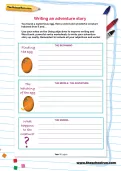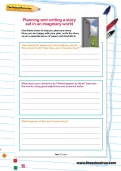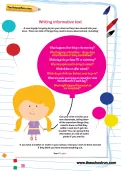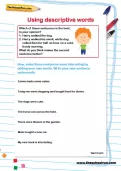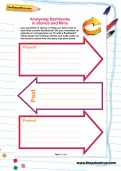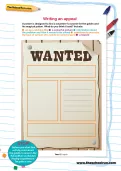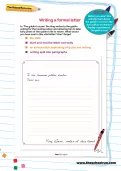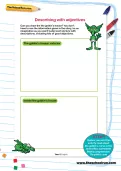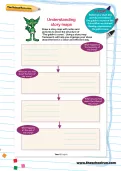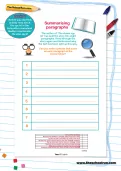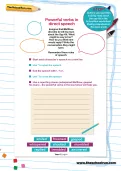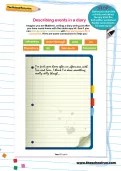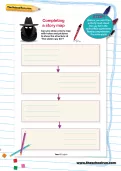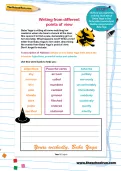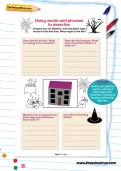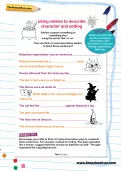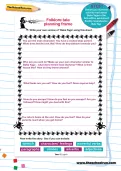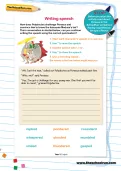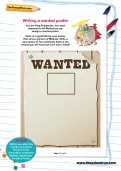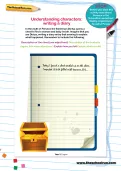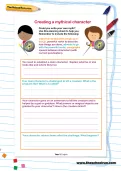Can you think of stories or films you have read or seen that contain flashbacks? Do you remember an episode of a programme on TV with a flashback? Think about one of these stories and write notes on this sheet to show how the story was structured.
or
Register to add to your saved resources
Already a subscriber? to view this content.
A poster is designed to find a volunteer to search for the goblin and his magical potion (from the story 'The goblin's curse'). What do you think it said? Include: an eye-catching title; a colourful picture; information about the problem and how it needs to be solved; adjectives to describe the type of person who needs to come forward; a reward.
or
Register to add to your saved resources
Already a subscriber? to view this content.
Read ‘The goblin’s curse’ first, then think about the letter that the king writes to the goblin asking for the healing potion. What would you have said in this vital letter? Don’t forget how to set out a letter correctly.
or
Register to add to your saved resources
Already a subscriber? to view this content.
Once you've read the story of The Goblin's Curse, imagine that you are the goblin, having just met Orion and given him the potion. Explain your meeting and then describe how you capture forty years of the queen’s life in a bottle. How do you feel about it all?
or
Register to add to your saved resources
Already a subscriber? to view this content.
Can you draw the the goblin’s house from the story The Goblin's Curse? You don’t have to use the information given in the story, be as imaginative as you want! Label each picture with descriptions, including lots of good adjectives.
or
Register to add to your saved resources
Already a subscriber? to view this content.
Using a story map framework will help you organise your ideas about the text in a clear and efficient way. Can you draw a story map with notes and pictures to show the structure of ‘The goblin’s curse’?
or
Register to add to your saved resources
Already a subscriber? to view this content.
The author of ‘The stolen spy kit’ has split the story into eight paragraphs. Read through the story again and think about why the text has been split up this way. Can you write a phrase that sums up each paragraph in these boxes?
or
Register to add to your saved resources
Already a subscriber? to view this content.
Start by reading 'The stolen spy kit' then imagine that Matthew decides to tell his mum about the Spy Kit. What might he say to her? How do you think she would reply? Write the conversation they might
have. Remember the rules of speech!
or
Register to add to your saved resources
Already a subscriber? to view this content.
This worksheet accompanies the reading comprehension: 'The stolen spy kit'. Imagine you are Matthew, writing a diary entry just after you have come home with the stolen spy kit. See if you can include longer sentences with two parts joined by a connective.
or
Register to add to your saved resources
Already a subscriber? to view this content.
Complete the reading comprehension: 'The stolen spy kit'. The see if you can draw a story map with notes and pictures to show the structure of the story.
or
Register to add to your saved resources
Already a subscriber? to view this content.
Read the story about Baba Yaga then imagine what happens when Natasha first arrives at Baba Yaga's house. Write a brief letter from Baba Yaga to her sister, describing the events from Baba Yaga’s point of view. Don’t forget to include: A description of Natasha; details of how Baba Yaga feels about the intrusion; adjectives, powerful verbs and adverbs
or
Register to add to your saved resources
Already a subscriber? to view this content.
Read the story about Baba Yaga then imagine you are Natasha, entering Baba Yaga’s house for the first time. Can you answer these questions about how the house might look?
or
Register to add to your saved resources
Already a subscriber? to view this content.
A KS2 English worksheet created by a teacher to help your child practise using similes to describe character and setting.
or
Register to add to your saved resources
Read the 'Baba Yaga' story then see if you can write your own version using the tips on this sheet to help. See if you can include powerful verbs, similes, adverbs and adjectives.
or
Register to add to your saved resources
Already a subscriber? to view this content.
How does Polydectes challenge Perseus and convince him to brave the fearsome Medusa’s lair? Their conversation is started below; can you continue writing the speech using the correct punctuation?
or
Register to add to your saved resources
Already a subscriber? to view this content.
You are King Polydectes. You want someone to kill Medusa so you design a wanted poster. Think of a good title for your poster, then draw a picture of Medusa. Write a description of her and finally think of the reward you will hand out once she is killed
or
Register to add to your saved resources
Already a subscriber? to view this content.
Think about the three things Athena gave Perseus to help him kill the Medusa. Write some phrases around each picture. You will need to... 1. Describe how the object looks – use plenty of adjectives! 2. Use a simile to compare the object to something else. 3. Describe the purpose of the object – what is it used for?
or
Register to add to your saved resources
Already a subscriber? to view this content.
In the myth of Perseus the fisherman Dictys opens a chest to find a woman and baby inside. Imagine that you are Dictys, writing a diary entry that evening to explain what happened. Remember to include the following: Description of the chest (use adjectives!); description of the contents (again, lots more adjectives!); explain how you felt; explain what you did.
or
Register to add to your saved resources
Already a subscriber? to view this content.
Think about the two kings in the myth of Perseus and how they feel in the story. Write a few sentences in each speech bubble.
or
Register to add to your saved resources
Already a subscriber? to view this content.
Could you write your own myth? Use this planning sheet to help you. Remember to include the following: adjectives to describe people and things, powerful verbs to describe how things are done, adverbs to go with the powerful verbs, paragraphs, speech between characters (with correct punctuation).
or
Register to add to your saved resources
Already a subscriber? to view this content.

